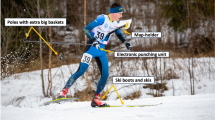Abstract
Air temperature and relative humidity have long been suspected of affecting the performance of marathon runners. Though these factors are important in their extremes, we show that other factors are even more indicative of race performances. Performances of the top 3 finishers in the last 30 Boston Marathons were correlated with hourly meteorological data for each race day. These 90 individual performances were classified as: record breaking performances (31), average performances (35), and unusually slow performances (24). The factors that help predict record breaking and unusually slow performances are: (i) wet bulb temperature, (ii) percent sky cover, and (iii) presence or absence of a light precipitation. Record breaking performances are characterized by a wet bulb temperature of <7.8°C, and 100% sky cover. A light drizzle is also conducive to better performances. On the other hand, unusually low performances are accompanied by a wet bulb temperature of >7.8°C, and a sky cover of 50% or less. No light, precipitation was recorded on any of the unusually slow race days. A graphic analysis clearly shows these relationships to exist. In addition, a multiple regression analysis confirms the importance of these variables. The authors advise that these are reliable predictors; however, when considering marathon races held in various geographical regions and differing climatic regimes, the exact numerical thresholds used here may not apply.
Similar content being viewed by others
References
Adams WC (1977) Influence of exercise mode and selected ambient conditions on skin temperature. Ann NY Acad Sci 301: 110–127
American College of Sports Medicine (1984) Position stand on the prevention of thermal injuries during distance runnings. Sports Med Rull 19: 8–12
Costill DL (1972) Physiology of marathon running. J Am Med Assoc 221: 1024–1029
Costill DL (1979) A scientific approach to distance running. Track and Field News, Los Altos, California
Dawson NJ, de Freitas CR, Mackey WJ, Young AA (1987) The stressful microclimate created by massed fun-runners. Trans Menzies Foundation 14: 41–44
de Freitas CR, Dawson NJ, Young AA, Mackey WJ (1985) Microclimate and heat stress of runners in mass participation events, J Climate Appl Meteorol 24: 184–191
Frederick EC (1987) No sweat Runner's World 24: 78–83
Holman R, Dick F (1982) Adaption to heat. Athletics Coach 16: 12–13
Kuehn LA (1977) Latulippe—A case study of a 160 km runner: Part two-environmental conditions. Br J Sports Med 11: 176–177
Maughan RJ (1984) Temperature regulation during marathon competition. Br J Sports Med 18: 257–260
Minard D (1961) Prevention of heat casualties in Marine Corps recruits. Military Med 126: 261–268
Wyndham CH, Strydom NB (1977) Körperliche Arbeit bei hoher Temperatur: Zentr Themen Sportmed
Author information
Authors and Affiliations
Rights and permissions
About this article
Cite this article
Trapasso, L.M., Cooper, J.D. Record performances at the Boston Marathon: Biometeorological factors. Int J Biometeorol 33, 233–237 (1989). https://doi.org/10.1007/BF01051083
Received:
Revised:
Accepted:
Issue Date:
DOI: https://doi.org/10.1007/BF01051083




